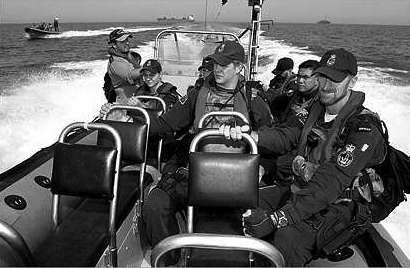- Author
- Johnston, Anthony, DSM, Lieutenant Commander, RAN and Francis, Richard
- Subjects
- RAN operations, Ship histories and stories, 21st century wars/conflict
- Tags
-
- RAN Ships
- HMAS Adelaide II
- Publication
- June 2007 edition of the Naval Historical Review (all rights reserved)
The boarding party was advised to maintain a low profile and stay out of sight as much as possible. It was with some relief that they realised that the Iranian gunboats could not get close enough to the merchantman in the shallow water. An attempt was made by some of the gunmen to board the ship via a commandeered cargo dhow, but this proved unsuccessful when the boat grounded on a sandbar some 65 yards short.
It was decided that it might be too risky to send the RHIBs back alongside to re-embark the boarding party, as the boats might be attacked, captured or sunk in any escalation, so they were ordered to return to the Adelaide. Indeed, the entire boarding party would run the risk of capture during a boat transfer back to the ship. Johnston decided to return to his ship refuel and to brief his command on the tight situation facing the recovery of the boarding party. PO Keitley later commented that the Iranians appeared to be testing the Australians’ resolve by being highly aggressive at times, then mellowing again afterwards.

(Image: Defence PR Photographic Collection)
Decision to recover
Meanwhile the tense situation had been relayed to other Allied forces in the area, to summon strong support in the event of outbreak of hostilities, or to prevent the capture of Adelaide’s boarding party by the Iranians. Ultimately the requested support was not forthcoming, and in the event, LCDR Johnston decided to recover the entire boarding party by winching them off the merchantman, without risking the boats. A dummy pass was made at low level to observe the reactions of the Iranian boats. This action tended to confuse them, although one in particular took up a close-in position, possibly to threaten the Seahawk in the hover.
Having relayed his intentions to PO Keitley, Johnston came in again and hovered low over the bridge. He winched off seven of the boarding party and promptly flew them safely back to Adelaide, less than 10 minutes away. He took off again immediately to attempt a similar operation for the remainder of the boarding party. This time the Iranian gunboats appeared more alert and tense, and Johnston was forced to carry out a series of approaches to mask his real intentions. Finally he came down low to winch the remaining members of the boarding party from the upper deck. Subsequently, while the evolution was precisely conducted in a remarkably short period, Johnston records it appeared to take ‘… an extraordinarily long five minutes…’ in the hover, and he swept away when PO Keitley was finally winched onboard, blindsiding the most aggressive of the Iranian boats by departing in the opposite direction to his earlier approach. Breathing a collective sigh of relief, the remaining boarding party members were returned safely to Adelaide.
Commenting on the situation much later, LCDR Johnston maintains that the ship’s previous mission-capability training, including the winching drills for all boarding parties, paid dividends when the crunch came in this unexpected incident. It was a measure of the dedication and professionalism of the entire ship’s team that a successful conclusion was achieved in the face of increasing threats and adversity, without having to rely on external armed support, which may well have led to a need to ‘fight it out’, perhaps with ensuing casualties, loss of prestige, adverse propaganda, or the indignity of capture in the circumstances.
The citation for the award to Lieutenant Commander Anthony Johnston of the Distinguished Service Medal reads:
‘For distinguished command and leadership in action as Mission Commander of HMAS Adelaide’s Seahawk helicopter during Operation Catalyst.
During December 2004, facing overwhelmingly superior and hostile forces and without the support of coalition aircraft or firepower, LCDR Johnston showed exemplary leadership, courage, composure and determination as Mission Commander and Scene of Action Commander to facilitate the safe extraction of HMAS Adelaide’s boarding party from perilous and harmful circumstances.’
Editor’s Note
In a recent well-publicised incident, a group of fifteen sailors from HMS Cornwall, operating in circumstances not dissimilar to those described above, were taken prisoner by the Iranians and held for about two weeks. In light of the similarities between that incident and the one described above, I invited LCDR Johnston to clarify the means by which helicopters, and more particularly RHIBs, fixed their positions in such potentially contentious waters.




